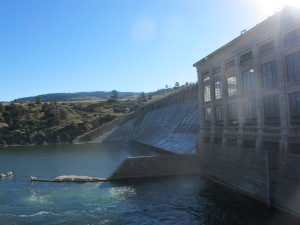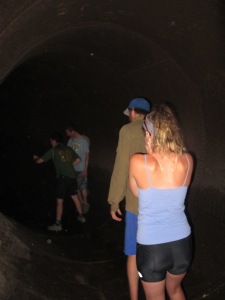 The wakeup call was 6:30 this morning below Holder Dam on the mighty Missouri River near Wolf Creek, MT. Today marks the best I have felt at 6:30am on the Fifth of July in my illustrious collegiate career. While working on a paper on a perch above the dam last evening, the Dam operator Tim and his wife came up to watch the fireworks, telling us we had found the best spot in the house to watch the locals celebrate their freedom to light up the night sky with low grade explosives. I asked him a few questions about the dam and how much power it was producing at what flow rates and so on. His wife chimed in and said we should just take a tour of the dam in the morning. Tim agreed and didn’t have to ask me twice, and after 6:30 wake up I asked our instructors if we could work the tour into our schedule, which would mean riding in the heat of the day to Choteau. Liz and Alan agreed the tour fit into the curriculum nicely and we were not scheduled to tour a Hydro-power facility, so we enjoyed a nice leisurely breakfast and packed up camp by 8:00 and went to meet Tim after he finished his morning duties.
The wakeup call was 6:30 this morning below Holder Dam on the mighty Missouri River near Wolf Creek, MT. Today marks the best I have felt at 6:30am on the Fifth of July in my illustrious collegiate career. While working on a paper on a perch above the dam last evening, the Dam operator Tim and his wife came up to watch the fireworks, telling us we had found the best spot in the house to watch the locals celebrate their freedom to light up the night sky with low grade explosives. I asked him a few questions about the dam and how much power it was producing at what flow rates and so on. His wife chimed in and said we should just take a tour of the dam in the morning. Tim agreed and didn’t have to ask me twice, and after 6:30 wake up I asked our instructors if we could work the tour into our schedule, which would mean riding in the heat of the day to Choteau. Liz and Alan agreed the tour fit into the curriculum nicely and we were not scheduled to tour a Hydro-power facility, so we enjoyed a nice leisurely breakfast and packed up camp by 8:00 and went to meet Tim after he finished his morning duties.
Tim was an amazing tour guide and gave us the best dam tour we could have asked for. The most in depth you can get while touring a hydro dam, let alone a PPL owned Dam in Eastern Montana. He started on the upper level of the dam, showing us the generators. One of the turbines was under repair, so we got to see the inner workings of the hub and the ginormous bearings that keep the turbine spinning smoothly. From there he took us to the upper levels of the dam and showed us the control room, which recently had a master control computer system installed to get the turbines moving, open the gates to allow water into the turbines, and so on. Previously putting the dam online involved flipping a plethora of switches at exactly the right time, using hydro exciters to get the turbines moving as opposed to the new electrical exciters which use energy from the grid to start the turbines.
The dam began its construction in 1908 and went online in 1918, back when the Red Sox won the world series before they were cursed by Babe Ruth and the Yankees for nearly 90 years. Tim gave us the option to crawl down a manhole on a ladder into the actual turbine itself; we jumped on the opportunity, knowing that this was a once in a lifetime experience. The group crawled down into the turbine that was under repair and closed off, and we entered the nearly hundred year old waterway. The water is channeled through this snail shaped tunnel that is thirteen feet wide at its widest point and gets progressively narrower as it spirals in towards the turbine in the center. As I looked up towards the floodgate that holds Holter Lake back all I could think of was the 95 year old door keeping the 60,000 acre feet of water from rushing in and  crushing us. Once I had wrapped my head around that, I was able to look at the early 20th century engineering and was amazing at how precise each rivet was, as welding was still a thing of the future when the dam was built. After having my mind blown by standing inside a 95 year old hydro-power turbine, it was time to head back up the rabbit hole.
crushing us. Once I had wrapped my head around that, I was able to look at the early 20th century engineering and was amazing at how precise each rivet was, as welding was still a thing of the future when the dam was built. After having my mind blown by standing inside a 95 year old hydro-power turbine, it was time to head back up the rabbit hole.
After the group had safely ascended the ladder I saw my opportunity to ask Tim what his thoughts were on climate change. He believed that the climate was changing, but believed it to be a series of natural cycles. He did however admit that coal may be having an effect on the climate, but stated that volcanoes and other natural sources contribute as much if not more than humans do. After bringing up climate change and energy use, Tim mentioned that the dam did not have a heating or air conditioning system, they rely on the heat produced by the turbine generators in the winter and they have big windows they open in the summer to keep the facility cool. This is a great example of conservation from almost a century ago, and also efficiency in terms of using the excess heat created during the energy generation process to heat the building. This is especially impressive when you consider the climate of Montana’s rocky mountain front 100 years ago.
After the tour, we began our ride from Wolf Creek to Augusta, just under 40 miles of riding along the Rocky mountain front. This was an exciting ride for many reasons, the first of which being this was the first time we really had any views of The Rockies as we rode along the Scapegoat and Bob Marshall Wilderness areas. As we approached Augusta, a van drove by and honked, then stopped in front of the group. Wild Rockies Field Institute’s Summer Semester group had spotted us and stopped to talk for fifteen minutes or so. We shared some laughs and then got back to pedalling. As I rode into town in Augusta, I had a strange feeling of déjà vu. It wasn’t until I reached the center of town that I realized why I knew this place: four years ago I began my Afoot and Afloat WRFI trip in Augusta with 10 strangers, as well as instructors Brandt Guyerman and Joshua Porter before heading into the Bob Marshall Wilderness for 9 days of backpacking. So far on this great adventure, today was the day, the day everything came full circle for me. In the same town I learned about Environmetal Ethics and Human Land Use issues, I can now apply those concepts to renewables and how climate change ties into the picture. Here comes the lighting, time to batton down camp and hit the picnic table for our ride to Choteau tomorrow.